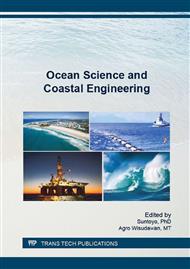p.55
p.61
p.67
p.72
p.78
p.83
p.90
p.96
p.102
Landsat 8 Imagery Data Utilization for Mapping the Dynamics of Cooling Water Distribution Based on Changes in SST in the Coastal Waters
Abstract:
Sea surface temperatures have increased since the early 20th century by 0.7 °C from 1989–2008. Changing ocean temperature directly affects the distribution and abundance of many species and habitats, including phytoplankton, coral reefs, and pelagic fish. For species that require shallow coastal water, such as for breeding or nursery grounds, the changes forcing by the changing temperature will eventually result in major population reductions as habitats become less available, and finally become unavailable. This research is presents the application of Landsat 8 for monitoring the dinamics and distribution area of sea surface temperature changed by the heated effluent discharge from the power plant on Bhinor village, Paiton, Probolinggo, East Java from 2013-2015. Remote sensing technology using a thermal band in Operational Land Imager (OLI) sensor of Landsat 8 sattelite imagery (band 10 and band 11) is used to determine the dynamics and distribution of sea surface temperature. The Split Window Algorithm (SWA) methods is used to perform extraction of sea surface temperature (SST) with brightness temperature (BT) value calculation on the band 10 and band 11 of Landsat 8. The extraction of Landsat 8 shows the temperature around the water outlet at is higher than the natural temperature (29°C). SST near water outlet showed an increasing trend from 2013 (33°C) to 2015(36°C).
Info:
Periodical:
Pages:
78-82
Citation:
Online since:
January 2017
Price:
Сopyright:
© 2017 Trans Tech Publications Ltd. All Rights Reserved
Share:
Citation:


